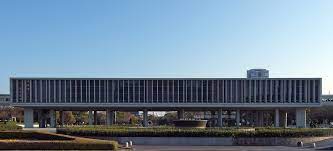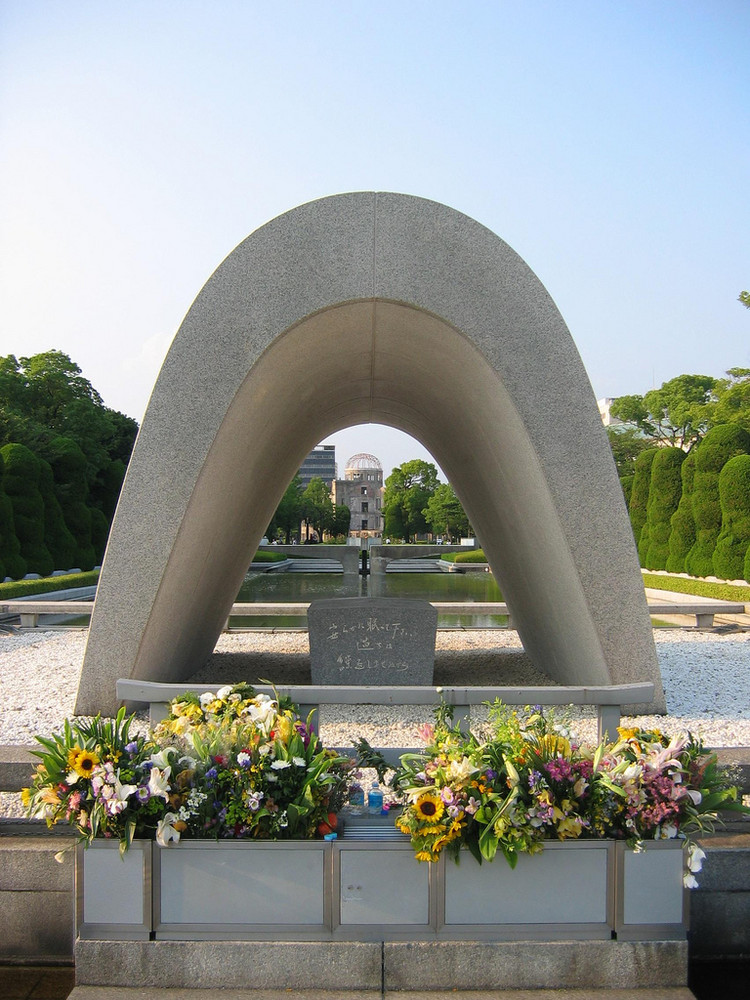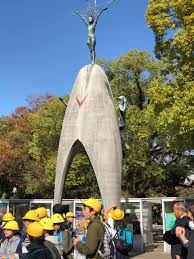The Hiroshima Peace Memorial Park, designed by the Japanese architect Kenzō Tange, lies in the centre of Hiroshima city in Japan. It is built on the site of the world’s first atomic bombing on August 6, 1945, and is dedicated to memorialising the victims, the city, and the legacy of the atom bomb. The park consists of several notable elements. The A-Bomb Dome is the most striking, consisting of the skeletal remains of the Hiroshima Prefectural Industrial Promotion Hall building, the closest remaining building to the bomb’s hypocenter. This is framed by the central Peace Memorial Cenotaph for the victims of the atom bomb. The park also holds the Children’s Peace Monument, a statue based on Sadako Sasaki, a young girl who died from radiation as a result of the bomb. Other elements include the undying Flame of Peace and the Pond of Peace. The largest newly-built structure in the Peace Memorial Park is the Peace Memorial Museum, a distinctly brutalist and modern structure.
The park was built from 1949 to 1955 amid heavy debate surrounding Japan’s future: in particular, around Japan’s role as both a victim and a victimiser, and whether Japanese tradition had any part to play in visualising a peaceful future. This is situated in the wider debate of the role of peace monuments: their purpose, their design, and their culpability in shaping and erasing collective memory.
The debate around the design process of the Peace Memorial Park is encapsulated in the controversy surrounding the designer himself, Kenzō Tange. Rising to prominence during the war, Tange’s wartime projects were embedded with government propaganda and imperialist sentiments. One such project was the Greater East Asia Co-Prosperity Sphere Commemorative Building, where Tange’s design incorporated the nationalist symbol of Mount Fuji and the emblem of imperial authority of the Ise Shrine.1 After 1945, however, he is hailed as a hero of post-war Japanese architecture, and his designs are forced to contend with a new Japanese identity. This shift was reflective of a greater process happening in Japan of what was perceived as ‘starting over’.2 Kenzo’s designs grappled with traditional Japanese elements that were connected to imperialism and a culture that was seen as to blame for the suffering of the country, and a reformulation of these characteristics for a peaceful future.3

The Hiroshima Peace Memorial Park does this partly through opting for a brutalist and modern design. Tange follows an international modernist style seen through the unadorned raw concrete structure of the Peace Memorial Museum, emphasising a more ‘honest’ approach. Other elements of the international modernist elements which Tange incorporates, such as a flat roof and windows with vertical or horizontal slats, show the movement of young Japanese architects toward a style that was associated with growing democratic values worldwide, a decided break with the nationalist and imperial elements that characterised wartime architecture.
This complete separation from Japanese tradition was challenged once Japan emerged from the Allied Occupation and its censorship in 1952. Increasing anti-US sentiment called for a critical perspective on Hiroshima as a city of world peace, a narrative seemingly built by a US suppression of Japanese values immediately after the war. Tange incorporated Isamu Noguchi’s designs that sought to blend tradition with the Hiroshima peace project, resulting in the central cenotaph for victims of the atomic bomb. The design drew on early Japanese art and culture, with the dome-like arch being reminiscent of traditional Japanese artefacts like the curved beads magatama, and the bronze ceremonial bell dōtaku.
In their attempts to build a new Japan without drawing on traditions and culture that defined the imperial structures of wartime Japan, architects looked to a time before modern civilization, to the prehistoric civilizations of the Jōmon and Yayoi people. Tange therefore reviewed his design for the Peace Memorial Park through the lens of the ‘primitive’ and robust Jōmon and aristocratic and decorative Yayoi cultures, symbolising the tension between the underprivileged and oppressed and ‘people power’ to create a monument for postwar democracy.


However, this peace narrative of a ‘new Japan’ and ‘starting over’ has been seen to facilitate a culture of collective amnesia towards Japan’s wartime past. One of Tange’s collaborators claimed that ‘the aim of the Hiroshima project was not to mourn the dead, which was a past-oriented and backward-looking act, but to commemorate peace, which was a future-oriented and forward looking act.’ Shinzō Hamai, the mayor of Hiroshima in 1949, stated: ‘The people of Hiroshima decided definitely to stand for peace and wanted to demonstrate it to the world by moulding their ruined community into a monument of permanent peace.’ Both these statements reflect the sentiment of suffering and destruction as something of the past, while the future holds an uncontested and uncomplicated peace. This reading allows little space for reconciliation and addressing the root causes of conflict, a vital part of building sustainable peace, especially given the context of Japan being a victimising power. This is reflected in the pronounced lack of mention of wartime events in the Peace Memorial Museum today, in perhaps an attempt to avoid the controversies of reconciling Japan as both a victim and a victimising power.
The Peace Cenotaph’s inscription reads: ‘Let all the souls here rest in peace; For we shall not repeat the evil.’ It has been mired in more recent controversy due to some perceiving the pronoun ‘we’ as attributing blame to the Japanese people and the victims, while others see the ‘we’ as referring to collective humanity. This raises questions about the role peace monuments play in fostering or mitigating a culture of blame, of reconciliation, and acknowledgement and how effective they can be in doing this. Which values of building peace do they choose to uphold, and the importance of matching these values to the cultural surroundings to enable a more constructive, and sustainable peace.
What do you think?
- How can peace monuments build toward a peaceful future while remembering the trauma of the past?
- Is critical reflection on past acts of violence a barrier to – or vital for – monuments that seek to build future peace and not just memorialise the past?
- What role can peace monuments play in peace education?
- Whose historical consciousness is prioritised in peace monuments?
- How are peace monuments weaponised in current debates surrounding conflict?
If you enjoyed this item in our museum…
You might also enjoy Douglas Gillespie’s Path of Peace, Sierra Leone Peace and Cultural Monument and Valentino’s ‘Peace Dress’.
Tao Yazaki, November 2023
If you want to read more:
- On the architectural design elements
- Inside the Peace Museum: Renewing and Reframing Hiroshima
- Jonathan M. Reynolds, Maekawa Kunio and the Emergence of Japanese Modernist Architecture (Berkeley: University of California Press, 2001).126 ↩︎
- Mikiso Hane, Eastern Phoenix: Japan since 1945 (Boulder, Colo.: Westview Press, 1996). 173–202 ↩︎
- Hyunjung Cho, “Hiroshima Peace Memorial Park and the Making of Japanese Postwar Architecture,” Journal of Architectural Education 66, no. 1 (September 28, 2012): 72–83 ↩︎